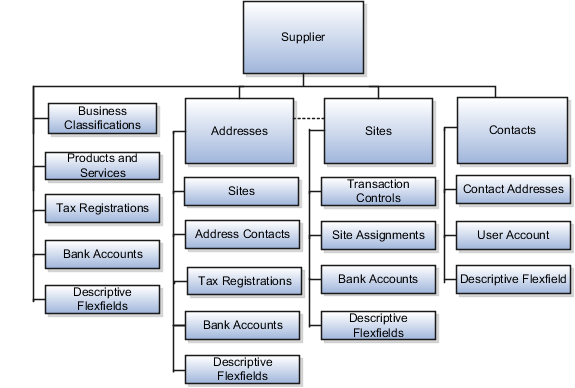Oracle Supplier Model
A supplier is modeled as a global entity. It isn't created within a business unit or any other organizational context.
A procurement business unit establishes a relationship with a supplier through the creation of a site which maintains internal controls for how procure to pay transactions are executed with the supplier. The other entities of the supplier profile capture mostly external information that is provided by the supplier, such as tax identifiers, addresses, contact information, and so on.
This figure shows a typical supplier definition and all its possible attributes. It also shows the connections between all the parts. For each supplier, there are four groups of attributes:
-
Addresses
-
Sites
-
Contacts
-
Miscellaneous information
Address attributes include:
-
Contacts - supplier personnel associated with that address
-
Bank accounts - any bank accounts associated with that address
-
Tax registrations - any tax information for that address
-
Sites - any business function associated with that site
-
Descriptive flexfields - any descriptive flexfields used with addresses
Site attributes include:
-
Transaction controls - any controls on the business functions conducted at that site
-
Bank accounts - any bank accounts associated with the site
-
Site assignments - for which the business units use the site
-
Descriptive flexfields - any descriptive flexfields used with sites
Contact attributes include:
-
Contact address - the address associated with the contact
-
User account - the contact's user account with the application
-
Descriptive flexfields - any descriptive flexfields used with contacts
Miscellaneous attributes can include:
-
Bank accounts
-
Tax registrations
-
Products and Services provided by this supplier
-
Business classifications applied to this supplier
-
Any descriptive flexfields used with suppliers.

Tax Registrations and Bank Accounts
Tax registrations and bank accounts, which include additional payment processing controls, can be defined at different levels of the supplier profile, providing more flexibility in conducting business with the supplier. These levels are described below, including additional relational aspects between entities.
-
Tax registrations can be created and maintained at three levels: supplier, address, and site.
-
Bank accounts can be created and maintained at three levels: supplier, address, and site.
-
A site must be associated with exactly one address. Multiple sites can be created for the same address. This approach is commonly used when more than one procurement business unit sources from the same supplier. You can create a site at the same time you create an address, instead of navigating to the Sites tab to create the site, after the address is created.
-
Address Contacts and Contact Addresses represent two ways an association can be made between a supplier address and supplier contact. This association can be established when performing maintenance in either entity. One address can be associated to one or more contacts, and one contact can be associated to one or more addresses. Additionally, when a contact is associated with an address, it is implicitly associated with all sites using the address. This establishes the concept of a Site Contact. Some transactions, such as purchasing documents, allow for a Site Contact to be selected on the transaction.
Prospective Suppliers
Buying organizations may engage with suppliers as prospective business partners. This prevents them from engaging in any contractual obligation, such as through a purchase order, or agreement. The prospective supplier can be invited only to participate in sourcing negotiations, or a supplier qualification process. If the prospective supplier is awarded business, the business relationship then changes to spend authorized. The buying organization can commit financially only to a spend authorized supplier.
Supplier Business Relationship Status
Suppliers are identified based on two types of business relationship status:
-
Prospective: Allows the supplier to participate in sourcing negotiations and supplier qualifications, but does not allow the supplier to be available for ordering and invoicing. The site profile entity as shown in the diagram above is not visible for prospective suppliers.
-
Spend Authorized: Indicates that the supplier is ready for ordering and invoicing. A request is initiated for a supplier to become spend authorized in one of the following ways:
-
You request the prospective supplier to be promoted to spend authorized from the supplier record.
-
The prospective supplier is awarded negotiation.
-
A supplier with intention of a spend authorized business relationship is created from an approved registration request.
-